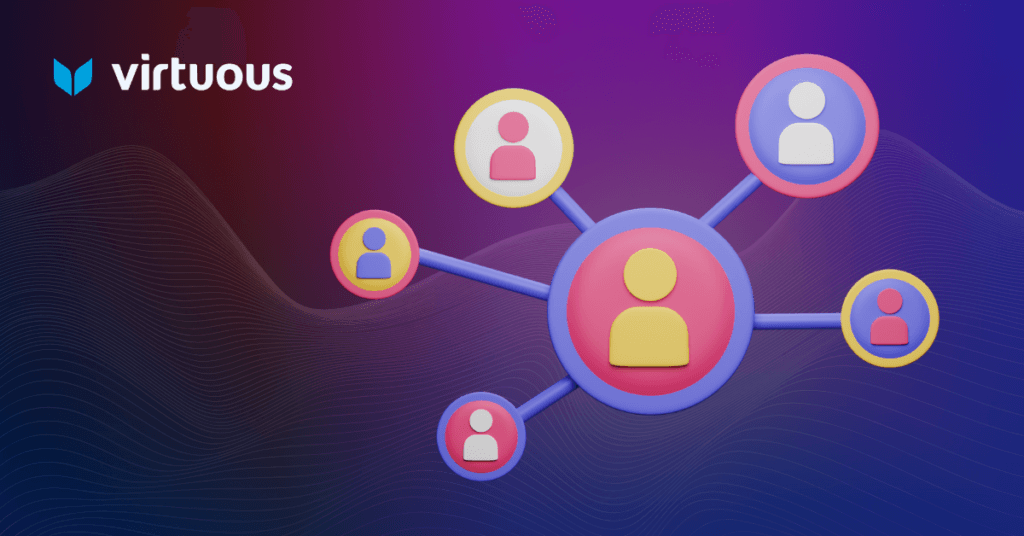Recurring donations are the lifeblood of every nonprofit organization. It’s the fuel to any sustaining nonprofit as it powers donor loyalty, advocacy, and even retention.
Donor retention has become a hot topic for nonprofits as organizations look for ways to unlock the giving potential of donors. The urgency of these conversations has only grown as the industry has encountered a generosity crisis. As a result, we’re experiencing a less-than-impressive donor retention rate. The Fundraising Effectiveness Project reports retention at 42.6%. Even worse, findings from the recent M+R report show a steeper decline—29% for one-time donors and 16% for first-time donors.
Not only does donor retention create more reliable revenue streams and a community of loyal donors and advocates, but it’s also a more affordable fundraising strategy. Research from Dr. Adrian Sargeant shows that acquiring a single new donor costs the same as retaining 5 existing donors.
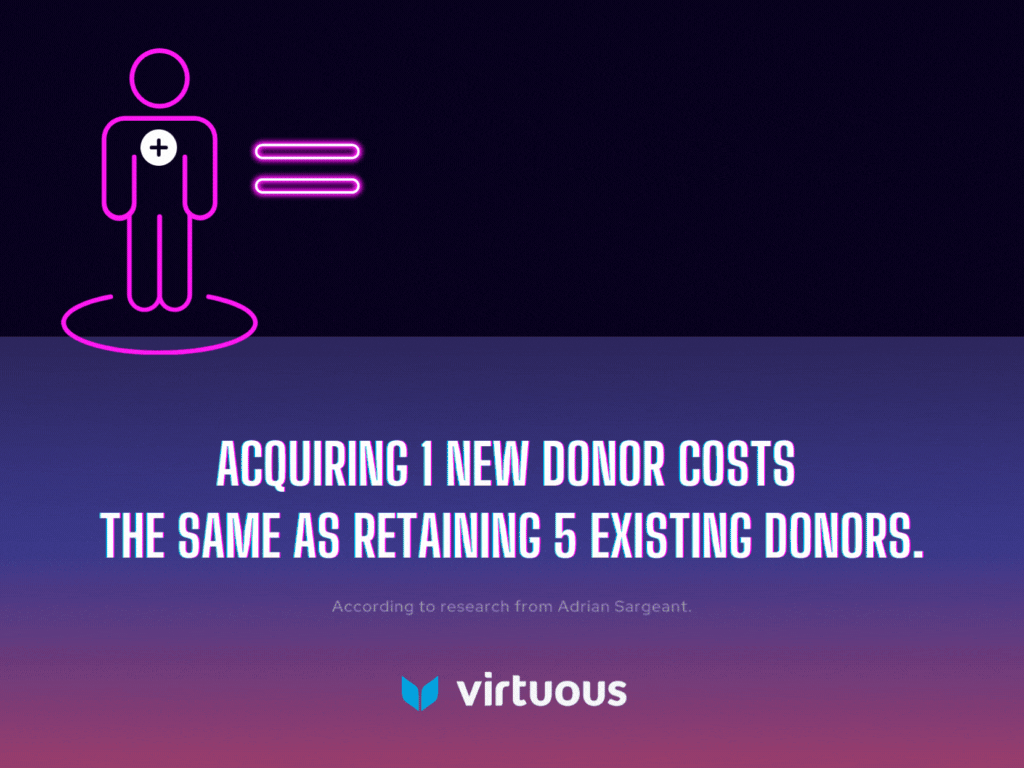
One of the most effective ways to grow donor retention is through recurring donations. The sooner a donor signs up to give on a recurring basis, the more they are committing to supporting your organization.
However, modern donors expect more from nonprofits. When a donor makes an online transaction anywhere else, the user experience (UX) they receive from our for-profit counterparts is next level compared to what they currently receive from nonprofits. Donors are accustomed to responsive experiences. Responsive experiences happen when the entire customer journey from start to finish is personalized based on their interests and interactions.
With multi-million-dollar-budget companies like Netflix and Amazon at the helm, nonprofits must take on a responsive fundraising mindset in order to compete for the attention of donors.
User experience (UX) encompasses all aspects of a person’s interaction with an organization, its services, and its products.
Why UX Matters for Your Nonprofit
Apps like Spotify can make tailored recommendations based on user preferences and activity. Retailers like Amazon can send us a reminder when we’re running low on a household staple. Donors have become accustomed to these responsive, hyper-personalized experiences in their day-to-day lives. A positive UX experience is no longer a nice-to-have for your nonprofit website—it’s become a necessity for top-performing nonprofits.
A responsive user experience on your website can do four things for your organization:
1. Gives your brand credibility among new donors
If your website is difficult to navigate (e.g., slow page load times, link errors, difficult to find basic information), odds are donors might become suspicious of the legitimacy of your website. An optimized UX creates more trust between your organization and its website visitors. This trust enables them to find critical pieces of information about your mission. A smooth, responsive donation experience can even lead to higher donation conversion!
2. Improves the way donors consume information
There are several reasons why someone might come to your website. They may want to make a donation, find educational resources on your mission topic, or learn more about how your organization is making a difference. Visitors will appreciate the ability to find what they’re looking for without the frustration of getting lost in your navigation.
Part of being hyper-personalized and responsive is centering your audience’s needs over your own. You may want everyone who visits your website to donate, but creating an experience that enables web visitors to find what they need, whatever it may be, quickly is going to create better long-term ROI for your organization due to increased trust and relationship-building.
3. Increases donor conversion and data collection
Better UX helps website visitors find what they need. In that process, there’s a chance that they might be moved to make a donation or register for an upcoming event. This is especially true if your UX is optimized to keep your organization’s mission top of mind for all website visitors. It’s easier to convert donors when they’re already on your website than to send a reminder down the road.
4. Casts a wider audience with the right accessibility features
In today’s digitally-powered environment, creating accessible and inclusive UX for everyone, including those with disabilities, allows you to connect with a larger audience. Becoming a responsive nonprofit means meeting your supporters, all supporters, where they are and creating an exceptional experience customized for them.
The Rise of AI: Personalization in the Donor Experience
With artificial intelligence (AI) embedded into every piece of technology that we touch, nonprofits need to start grappling with what this innovation means for them. AI might come with its intricacies, especially for those who work in data intelligence, but it doesn’t have to be complex. It can be as simple as making decisions, suggestions, or predictions based on the information it collects.
Artificial Intelligence (AI) involves using computers to do things that traditionally require human intelligence. AI can classify, analyze, and draw predictions from data. It may also take actions based on data, learn from new data, and improve over time.
AI has elevated how nonprofits can personalize the giving experience. Similar to the way Amazon is able to make recommendations—if a website visitor reads an article about clean water initiatives in Asia, AI might be able to suggest donating to the water project in Thailand. As another way to personalize the giving experience, AI can provide suggested donation amounts customized for each donor based on data like demographic, device type, or geographic location.
This creates a truly responsive giving experience for your donors. Just like the hyper-personalized suggestions for future purchases, TV shows to watch, etc., your organization can give hyper-personalized suggestions on how donors can best support your organization’s mission.
How UX Can Impact Recurring Donations
Believe it or not, UX plays a pivotal role in the success of your recurring donations program. While shared interest and passion might get some new donors through the door, an unresponsive website could deter them as well.
What does an unresponsive website look like for a nonprofit? One where information about the monthly giving program is hard to find or doesn’t exist on the website altogether. In other cases, there might be roadblocks to the donation experience, like limited payment options or broken links.
You want visitors to easily find information about your program. At the same time, you want to provide a seamless donation experience. Create one that empowers supporters to quickly make a donation and set up recurring payments. Ideally, donors can do this without the need to ask your team for support.
Let’s do a quick audit of your recurring giving experience. Here are important factors to consider:
- Is your monthly giving program highlighted somewhere on your website?
- Can interested donors find more information about your program, its impact, and any benefits or perks other than a line that says “Become a monthly donor”?
- Do you separate forms for one-time and recurring giving?
- Are existing regular donors able to make any updates to their plans without having to call in and talk to someone on the phone?
- Is there any marketing around your monthly giving program?
- Do you consistently communicate with your recurring donors, or do they only hear from you to update their payment information (e.g., expiring credit card)?
Further reading: Check out the Online Giving Playbook to help you get the most out of your online giving experience. Whether you’re a responsive nonprofit or taking your first steps to becoming one, this will help you grow giving online.
5 Ways to Improve UX for Recurring Donations
Unlocking more regular gifts is game-changing for nonprofits. It’s a proven, dependable way to level up your donor retention rate. To inspire the ongoing generosity of your most loyal donors, consider making these five tweaks to your online giving experience:
1. Contextualize Value in a Landing Page About Recurring Donations
How are you explaining the value of subscription philanthropy? If your only method of encouraging donors to upgrade their gift is by offering a “donate monthly” call to action, the majority of donors might ignore it and continue making a one-time donation. Again, responsive fundraising challenges fundraisers to consider the viewpoint of their donors. You may understand the value of monthly donations, but do your donors?
As a way to promote your monthly giving program, carve out a section of your website dedicated to sharing detailed information about your program and why it was created. Your landing page should outline the purpose of your monthly program. It should also highlight the power of monthly donors and showcase the impact you’ve made with your recurring support.
Heidi’s Village highlights its monthly donor program, “Heidi’s Heroes,” which is nestled under its “Support” tab in its navigation bar. The landing page is straightforward to find and explains why current donors should consider signing up for the monthly program.
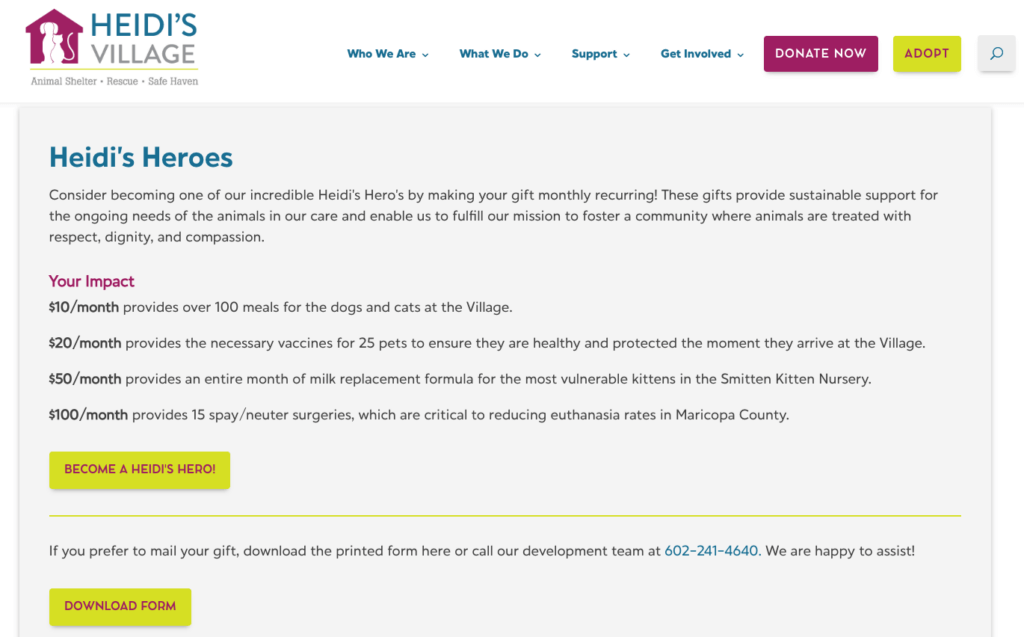
Organizations like Heidi’s Village lean on Virtuous’ responsive nonprofit CRM and marketing automation tools to create personalized donor journeys for every type of donor. This helps the team steward relationships with donors to unlock ongoing generosity at scale.
“That personal relationship is so important. Connecting with donors in a personal way and making them feel valued and noticed. If you’re a donor, you’re probably going to get five or six different thank-you notes, handwritten from various members of our board, me, my CEO. I liked being able to personalize and automate a lot of that functionality.”
Lisa Evans Johnson, Chief of Staff at Heidi’s Village
2. Unify the Experience of Recurring Donations
Give all of your donors a unified donation experience. But what does that really mean?
Whether your individual donor is looking to give a one-time gift or sign up to be a monthly donor, you want to ensure the giving experience is dynamic and not broken up into two separate online donation forms. If your UX happens to be the latter, there’s a chance that donors will go on to complete the one-time donation form, not even realizing there is a separate monthly donation form.
Putting all donation frequencies on the same online donation form enables donors to see all of their options and can even increase the rate of recurring donor conversion, eliminating the need for a standalone monthly donation form.
Dogs on Deployment: A Case Study on Unified Giving Experiences
Dogs on Deployment understands the value of a unified giving experience. Potential donors can toggle between one-time and recurring giving options and select their donation amount. Interested donors will also see an FAQ sidebar that includes additional information on why they should give monthly, furthering the organization’s case for support.
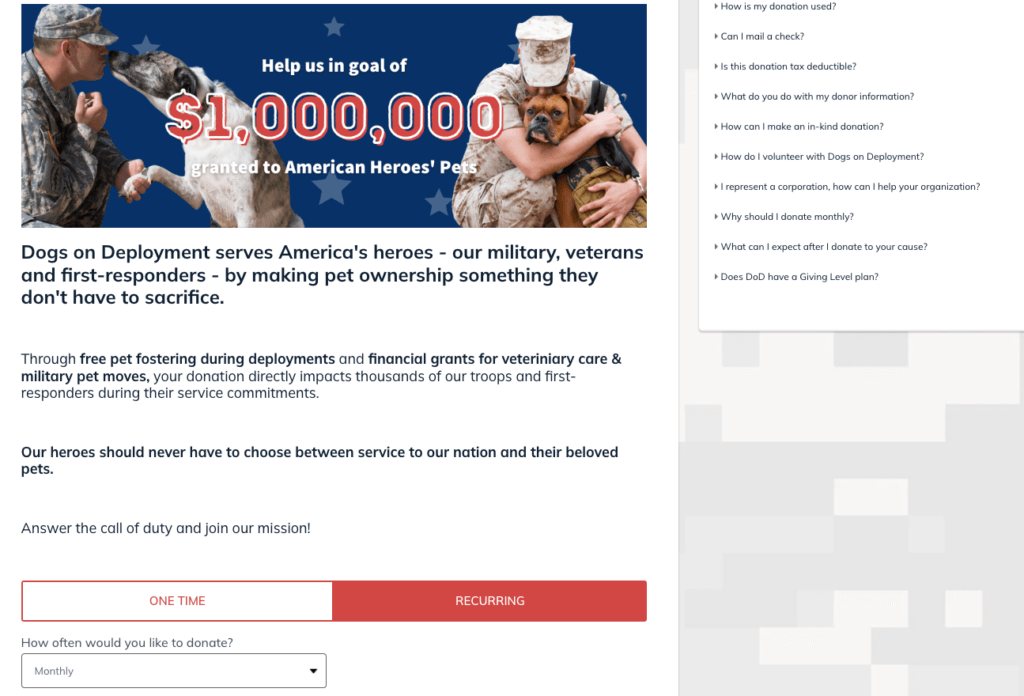
With a renewed focus on the giving experience, Dogs on Deployment needed a new nonprofit CRM. They needed something that could provide comprehensive data intelligence about donors. They also wanted to create personalized donor communications and integrate with its existing online donation platform, Classy. With support from Classy’s Customer Success Team, the organization implemented Virtuous. This partnership has resulted in time savings, more personal donor connections, and an increase in recurring giving.
“Choosing a CRM for your fundraising strategy can seem like a large investment. If you use it properly and have a strong strategy, you’ll see that the investment is worth it.”
Alisa Johnson, President and Co-Founder of Dogs on Deployment
In their first eleven months using Virtuous and Classy, Dogs on Deployment grew their giving by 94.6%.
When a donor upgrades their gift to recurring, you’re increasing that donor’s lifetime value. For example, let’s say someone was planning on contributing one $50 donation for the year. By prompting them to give smaller gifts throughout the year at $15 a month, that would be a 260% increase in annual lifetime value.
3. Connect Recurring Donations to Impact
Your prospective donors appreciate when you’re transparent about the ways you’re using their contributions to fund your mission. By including relevant information about donation amounts, you’re building trust with supporters. The more supporters trust your organization, the more they’re willing to sign up for monthly donations.
An effective way to communicate the impact of certain donation amounts is by highlighting impact levels on your website. On The Freedom Story’s monthly giving program page, the organization showcases three giving levels:

With a comprehensive understanding of how their monthly gift can help prevent child trafficking and exploitation, donors can commit to monthly plans without wondering how much of their donation is going toward the mission.
Note: For your organization, one internal impact of recurring donations is creating a more reliable revenue stream. This is perhaps not the impact you should highlight first to donors, but it certainly matters. Having a consistent source of revenue means that your team is able to focus on other high-impact activities.
4. Give Donors Full Control Over Recurring Donations
Make it easier on your donor base by giving them the power to manage their own monthly gifts. Similar to the way for-profit companies allow consumers to manage their subscriptions through an online portal, nonprofits can do the same.
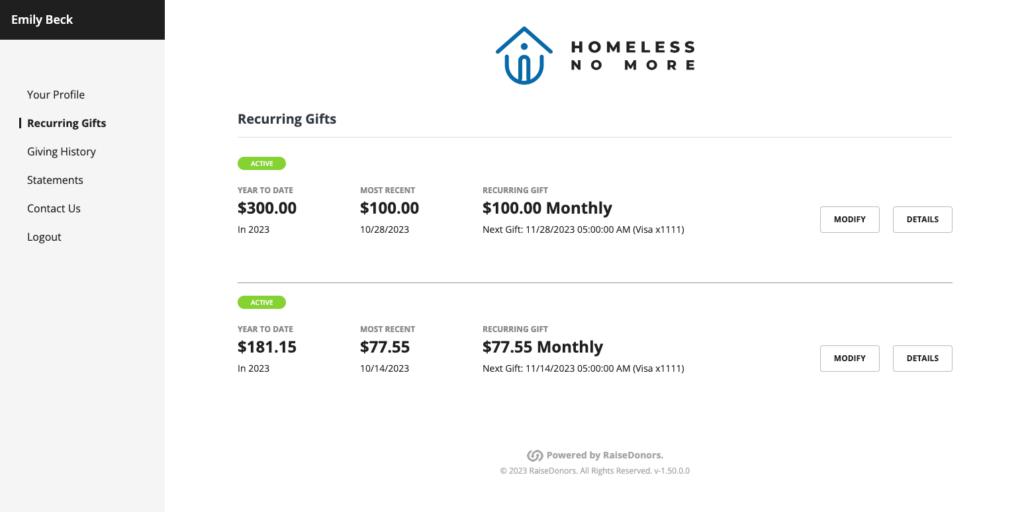
Instead of dealing with the pressure of calling your support line, donors can manage their plans online. They can make updates on a regular basis—like increasing their monthly contribution amount, changing donation frequency, managing donation receipts, and updating payment information. With the right online fundraising tool, your nonprofit can send reminder emails about any expiring credit cards.
This saves both the donor and the organization time and frustration from a long-winded phone call on a task that could be completed within minutes online.
5. Celebrate the Milestones of Recurring Donations
Your frequent donors deserve to be recognized for their recurring generosity! But how can you streamline this process so that your team doesn’t have to manually keep track of big milestones?
The manual work of recognizing major donor milestones can be a hassle. It requires combing through your recurring donor list and confirming total giving with your accounting department.
With responsive fundraising, you want to listen to your donors (What are they doing? What signals are they giving you?) and make meaningful connections as a result of what you learned. That hyper-personalization is what makes your organization’s emails and other communications break through the noise. If you use the right platform, you can create automated donor journeys that trigger communications, tasks, and more based on donor activity.
For example, create a donor journey for welcoming first-time donors to your organization. Then, whenever someone makes a first gift, the automated workflow is immediately triggered to walk them through that journey to encourage them to stay engaged. To get even more responsive and personalized, create a unique first-time recurring donor journey that has engagement activities uniquely created to celebrate those recurring donations!
Virtuous Applied
Automated donor journeys sound great, but how easy are they really? Virtuous’s responsive fundraising platform is built on the principle that nonprofits deserve the same quality of technology as for-profits but in a tool that is simple and easy to use. Check out the video below to see an example of how easy it is to create a first-time donor journey in Virtuous!
Virtuous’ marketing automation tools have made such a difference for organizations like Zoweh. “The automation workflows in Virtuous have been spectacular. We didn’t have anything like that before we moved into Virtuous. It’s helped us get all of our systems and processes to the point where they’re working for us and not against us. That has saved us so much time.”
Christopher Matthews, Digital Director at Zoweh
Since switching to Virtuous, Zoweh has experienced a 5% to 10% increase in recurring donors.
The Power of Personalization for Recurring Donations
Being able to personalize the donor journey allows your team to create meaningful connections while also saving staff time. Donors give for a variety of reasons, but those reasons are all fundamentally personal. Recurring donors are likely even more passionate and personally connected to your cause. Creating hyper-personalized experiences for recurring donors is simply a must. Automation makes that much easier for fundraisers to accomplish at scale.
For Heidi’s Village, Virtuous makes it easy to recognize donor milestones. “I’m focusing on donors that have hit certain milestones,” Evans Johnson says. “We’ve started to create a story around closing the loop for our donors. Now we can send emails with specific information and how that relates to our cause.” Being able to connect donors to the impact of their dollars helps the organization bridge the gap between donor generosity and the good that is accomplished.
UX and Responsive Fundraising Go Hand in Hand
Responsive fundraising puts donors at the center of all of your fundraising efforts, whether you are trying to grow recurring donations, acquire new donors, or re-engage with lapsed donors. With responsive and personalized UX that is crafted to meet the evolving needs and expectations of your donors, your organization can deepen engagement, strengthen relationships, and garner more ongoing generosity.
Are you ready to take the next step and learn how an optimized UX, paired with the power of responsive fundraising, can lead to an increase in donations and team effectiveness? Download “The Responsive Maturity Model: 5 Key Building Blocks to Drive Increased Generosity” now.

